Hermann Luttmann is a very prolific designer and frankly has designed a few of my most favorite games including In Magnificent Style: Pickett’s Charge, Dawn of the Zeds and At Any Cost: Metz 1870 among others. A few years ago, he announced a new game with GMT Games that is a cooperative horror based game where the player fights against zombies (they aren’t actually referred to as that in the design, but we all know what they are!) called The Plum Island Horror. I have been negligent in getting with him about this game but with Halloween coming up I wanted to get this interview done as a thematic touch to the holiday. I reached out to Hermann and as always he was very willing to do this interview with us.
*Note: The pictures and game art used in this interview, and pictures showing any of the various components and cards, are still in design and are intended to be illustrative at this point. Also remember that rules might still change prior to final development and publication.
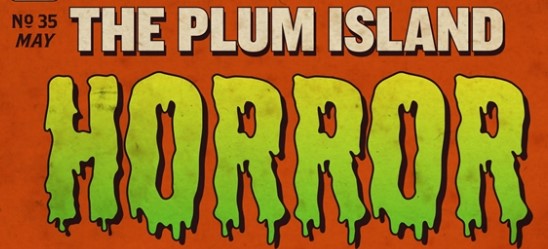
Grant: Why do you like doing designs on zombies?
Hermann: Well, technically, The Plum Island Horror is not a zombie game. 😊 In fact, the word “zombie” does not appear anywhere in the game literature. However, I understand that many would consider it a zombie game in spirit. From a design point of view, I enjoy zombie games for a few reasons. Zombies have been a cult favorite “baddie” for many years now – in movies, TV shows, novels, video games, etc. So, utilizing their popularity in a game design just makes good marketing sense. They are also scary villains and conjure up all sorts of horrific, visceral feelings for the player. They are unthinking, emotionless and unrelenting killing machines that try to basically eat you and … even scarier … convert you into one of them. The fact that they were once human – and could indeed be someone you know or worse yet, one of your loved ones – brings the terror to another level. Finally, for a game designer, zombies are much easier to control gameplay-wise. Writing up the “A.I.” rules is much simpler than with other antagonists as zombies normally tend to go straight for the players and will try to attack them at every opportunity. Not much “I” in their “A.I.” routine! Yeah – zombies are just plain fun, popular and relatively easy to design into a game.
Grant: How does the design process for this type of game differ from a wargame?
Hermann: I’ve spoken about this quite often on podcasts and interviews and the best way I can summarize my feelings about this subject is that I consider a game like The Plum Island Horror a designer’s “palate cleanser”. What I mean by that is that historical wargames, regardless of design footprint, require a lot of detailed work and tons of research to do correctly and accurately. As a designer, you are not only designing a game system but also a historically accurate simulation of a battle or campaign. This requires that you get all those aspects correct and also be able to present them in the game design accurately. A game like A Most Fearful Sacrifice required a year of hard work, taxing not only my ability to design a realistic ACW operating system but also my ability to research and create thirteen unique scenarios. So, when I get the opportunity to design a horror, science fiction or fantasy game, it is a welcome relief in that I can concentrate on just designing a fun game to play – without the worry of doing the required extra voluminous research. I design mechanics and systems that will entertain first and the justification comes later. It is far more relaxing and fun to create a fictitious world to go along with the system that you’ve designed. It is a way to reach into your “inner designer” and just create as entertaining a game experience as possible without worrying that you have a brigade arriving a half hour later than it did historically. And that’s why I consider these types of games “palate cleansers”.

Grant: What is your upcoming game The Plum Island Horror about?
Hermann: Well, it’s a typical Hermann Luttmann game … consumed by totally hellacious chaos, death, and destruction with the players losing miserably, of course! The story is actually about a “super storm” that plows into the vulnerable atoll of Plum Island. Plum Island is an isle off the Carolina coast and its population center is the vibrant seaside town of Greenport, located on the south coast of the island. The predominant employer and revenue generator for the community is the Plum Island Research Laboratory (P.I.R.L.), known locally as “The Pearl”, on the north shore. It’s an enormous facility that conducts government-sponsored biological research and experimentation. After the hurricane, the entire island was crippled with all power lost and the lab’s cylinders (containing the most hazardous biological agents) suddenly rupture. The entire facility was inundated with a horrific lethal mixture of chemicals, resulting in the staff and residents in the area being mutated into “Horrors”. The Horrors quickly evolved into vicious killing monsters, who soon turn their attention on reaching Greenport on the other side of the island. So, these abominations begin marching across the island toward Greenport and it’s up to the players to band together and stop them, while also rescuing the defenseless inhabitants of Plum Island. Very uplifting stuff!
Grant: What was your inspiration for the design?
Hermann: Ever since I lost creative control of Dawn of the Zeds (kind of), I’ve wanted to do a true cooperative horror game. It was actually while I was working on Miracle at Dunkerque for Legion Wargames that it dawned on me that the situation of the Dunkirk evacuation during World War Two could easily be re-interpreted as a horror game, with the players desperately trying to hold back an on-rushing evil horde while also simultaneously attempting to evacuate people. You can see that influence in the dynamics that play out in The Plum Island Horror.
Grant: What is the fictional setting for the game?
Hermann: Sometime in the future, set on a fictional, somewhat isolated island in crisis. I got the idea for “Plum Island” from the actual island located off the eastern end of Long Island. It is the home of a laboratory that handles and studies animal diseases and has a notorious and mysterious reputation. So, I thought it would fit perfectly into the game’s theme.
Grant: How does the game combine cooperative play with tactical-level unit management? What units are players managing?
Hermann: Each player will control a unique faction, each of which is made up of six individual units: one Leader unit (who has special command abilities), one Compound unit (a building unit that is a fort and haven) and four regular Player Units. Players conduct various actions with these units each time their faction is active (which is randomly determined), along with each time they opt to take a Follow action (which can occur after another player’s turn). Each unit has its own characteristics as to how it moves, fights, administers, etc. Players will need to work together in dealing with the ever-changing situation by manipulating their particular units’ strengths and weaknesses in coordination with the other players. The gameplay essentially becomes a dance, with each player hopefully matching their steps with their partners.
Grant: What are the 6 unique factions included in the game? How do they differ from each other?
Hermann: The various factions are:
NEIGHBORHOOD WATCH: In reaction to a police department corruption scandal, some citizens (lead by some military veterans) formed the Neighborhood Watch. This group acted as a bulwark against the rise in crime and sinking quality of life on Plum Island. The faction is lead by former Navy SEAL Biff Rogers and prides itself in being quick and agile, able to navigate the island and having a precise knowledge of all its nooks and crannies. They also know how to live off the land and can fend for themselves. This “weekend warriors” faction can put up a good fight on its own accord, and also provide bread and bullets to the other factions.
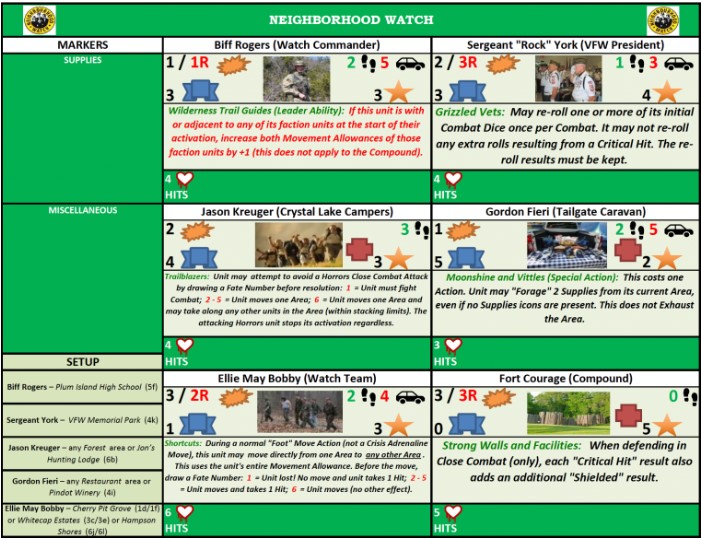
GREENPORT TOWNSHIP: The town of Greenport is the second largest employer and the cultural center for the island. This faction represents the town’s governing body and is led by Mayor Andrew Mayberry, a friendly, smart politician. It is made up of those municipal departments that serve the town and maintain the island’s infrastructure. The faction thus specializes in repair, maintenance, and civil service. It has units that can pick up and deliver other units and another that specializes in repair work. For combat, the “bravest” of the Greenport Fire Department are tough enough and can wield fire hoses with great skill. Overall, this faction is very well balanced.
PLUM ISLAND CONSTABULARY: This faction consists of one of the elite police forces in the eastern U.S. It prides itself first in its ability to “guard and provide” for the populace of the island. It is great at crowd control and other community-based actions while also having units that are well-armed and have Ranged Combat capability. This faction also has the only mobile Compound unit in the game. Their Paddy Wagon unit can provide protection, firepower and be relocated when needed (a veritable fort-on-wheels). The Constabulary is a deadly opponent for the Horrors but can also provide valuable social services.
PLUM ISLAND RESEARCH LABS SECURITY SERVICES: The “Pearl” was at the center of this crisis and many accusatory fingers have been pointing at the lab’s Security Services in particular since the tragedy occurred. This faction represents not only the physical “screen” of security guards who patrol the buildings and structures, but also the intellectual “screen” of scientific staffers who are responsible for the integrity of the research. This is probably the most specialized faction of the six in the game. Its main strength is being able to use its scientific prowess to curtail the spread of the biohazard infection, but it does so with the use of mostly experimental and untried procedures. This is a very challenging faction to run alone and probably needs to be paired with a heavy-combat group. The faction does have its Security Guards unit, which zooms around on their Segways and is trained to fire on the move … so there’s that.
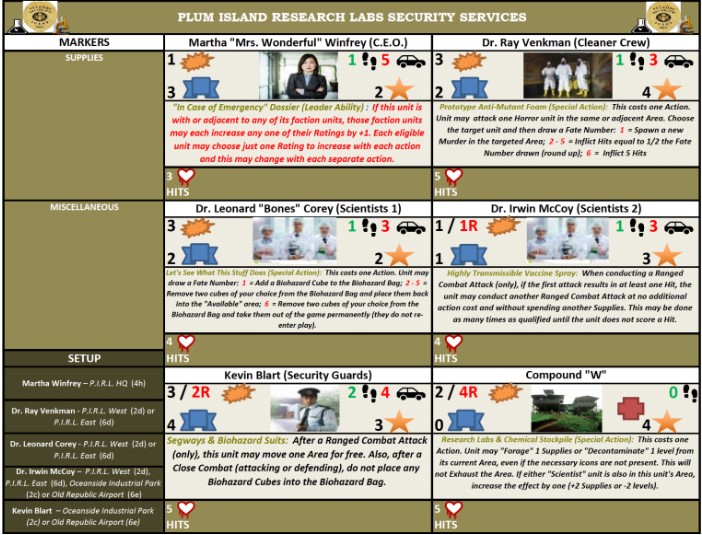
NATIONAL GUARD: This is a big time military contingent and probably a wargamer’s favorite faction. Big guns, fancy equipment and cool tactics. As powerful as they are, they are not all immediately available to you. There is only a small contingent at game start and it takes time to muster these forces. Units only enter the game one per Game Round and only at a secure helipad, beach or docks area. So the other players must help clear the way for the guardsmen. The National Guard is a hard-hitting and deadly faction that will eliminate a ton of Horrors – if the game hasn’t gone into the tank by the time they all get deployed.
ISLANDERS ATHLETIC CLUB: When the disaster occurred, the IAC was holding numerous sporting events around the island, so a great many athletes were present when the storm hit. As such, they have banded together to form a faction consisting of dozens of talented athletes, under the experienced guidance of Coach Calhoun. This faction is versatile, and a good one to have in your player array. The swimmers can move from one beach or dock to any other beach or dock on the map, providing great maneuvering flexibility for the player. The doubles tennis and golf foursome pros have unique Ranged Combat abilities, one issuing deadly tennis ball serves and the other long-range golf ball drives. And the groundskeeping crew can “mow down” (literally) swaths of Horrors in Close Combat with their riding mowers.
Grant: I read where you said “each faction has unique flavor and all of the tools needed to get 80% of the job done”. What did you mean by this statement?
Hermann: Simply, no single faction has everything needed to win the game. Each contributes different elements to the game play and strategy, and each can hold its own. But no faction has the answer to every situation and each needs to lean on the others in certain situations. The factions that best combine combat, administrative and scientific talents will have a chance to win the game, but no one faction (or type of faction) can do so on its own.

Grant: What is the function of a faction’s Leader unit? What are the other units that make up a faction?
Hermann: The Leader unit has a special ability that allows him/her to provide powerful bonuses and/or tools to the units of their faction (only). They are essential to victory and to extracting the maximum benefits from the faction’s units. The other special unit is the Compound, which is a fortress and a place that will not only provide defensive protection to units but that can also accommodate refugee units that are in danger and can’t be evacuated properly. The four regular player units are the common units for each faction, and each has something simple, but special, that they can do.
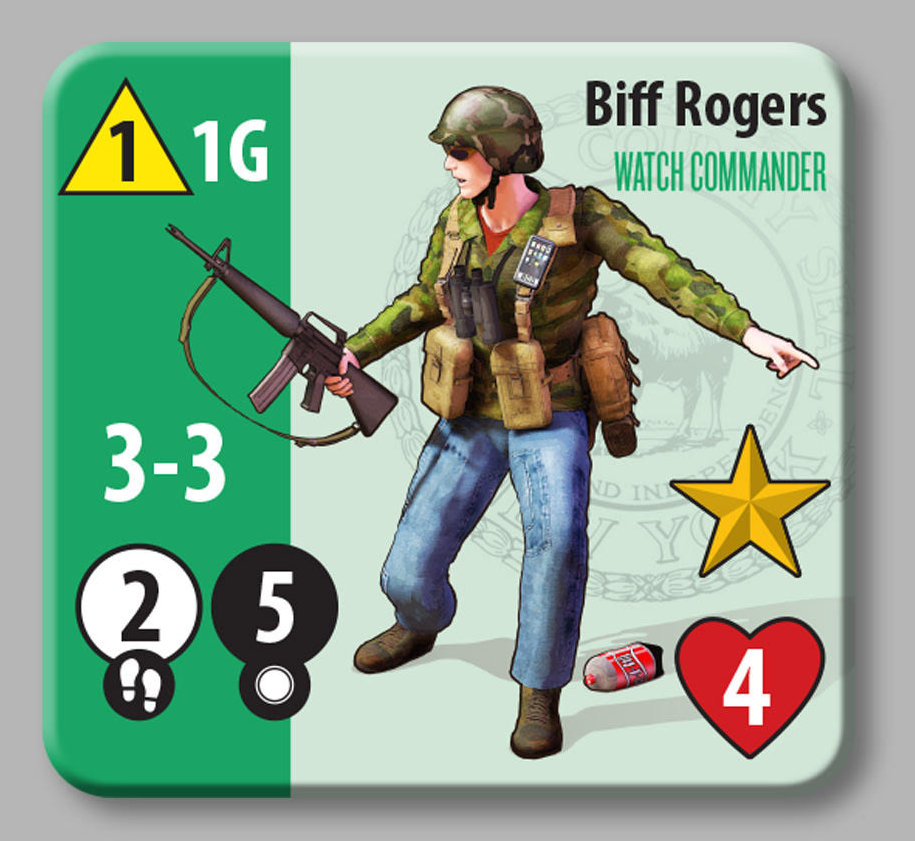
Grant: What is the anatomy of the units and their standees?
Hermann: Player Units are represented on the map with a counter and standee (as are the Horror Mutations). A Player Unit counter has the following values listed on it:
Combat Rating: The number of Combat Dice the unit may roll when conducting Close Combat. If there are two numbers present separated by a slash (/), the first number is used for Close Combat resolution and the second entry used for Ranged Combat resolution.
Movement Allowance: Indicates how many Areas the unit can normally move using a Foot Movement action. If there is a second number entry (with a “vehicle” graphic), then this unit also can use Vehicular Movement (which is obviously faster).
Admin Rating: Indicates the unit’s capability to get administrative and societal jobs done effectively – helping the civilian population, arranging logistics, etc.
Bravery Rating: Shows the unit’s ability to psychologically withstand the horrors it is encountering.
Heal Special Ability: If a unit has a “red cross” displayed, then it has the Heal action ability (which removes Hits from friendly units).
Special Ability: Each unit has a special ability described in detail below its ratings. Most of these abilities are passive and always “on”. Some units have a powerful Special Action as their ability, but these require the expenditure of an Action to use.
Toughness Rating: This indicates how much physical damage a unit can absorb. As soon as the number of Hits equals or exceeds the listed rating, the unit may be eliminated. I say “may be eliminated” because players units get a “Last Stand” attempt. The player draws a Fate Number and checks it against the unit’s Bravery Rating. If it passes, it will survive … barely.
Grant: What is the tower-defense style survival mechanic? Is this similar to a States of Siege Series game?
Hermann: The “tower-defense” aspect of the game is built into the victory conditions. Simply put – you and your group must defend the town from being overrun by the monsters. But the extra wrinkle that is added to this design is that there are also other ways to lose as well. So, if you manage to keep the Horrors out of the town, bravo for you. But if in the process you have the entire population of Plum Island wiped out … or if you allow the infection to become so toxic that it crosses onto the mainland … or if a player loses all their units … well then, you lose the game one of those ways anyway. You can say that the design is influenced by States of Siege, and that’s a tribute to Darin Leviloff’s brilliant core system, but The Plum Island Horror branches out into many different paths from that initial framework.
Grant: How does the variable turn order system work? How are factions determined to go?
Hermann: The order system is a simple random draw mechanic, inspired by the terrific deckbuilding game Aeons End. Players will be drawing cubes out of a bag – each player faction has a colored cube in the bag, along with three red Fate Cubes and a black Impending Doom Cube. If a player’s cube is drawn, they activate their faction and conduct eligible actions; if a Fate Cube is drawn, the players will draw a Fate Card which will determine what the Horrors will do; if the Impending Doom Cube is drawn, the players will draw an Event Card and resolve it. So as you can see, every Game Turn will play out differently and that adds immensely to the tension of the game and the need for the players to communicate and coordinate.
Grant: What is a Horror-Activation Cube? How do these cubes effect the game?
Hermann: The Horror-Activation Cube is actually called the Fate Cube, as it triggers the drawing of a Fate Card. The Fate Card will have various instructions on it for the possible spawning of more Horrors (placing new units onto the map in the Spawn Zones of one or more tracks) and/or the possible activation and movement of existing Horrors, causing them to advance down their tracks. There are occasional special activations that can also occur, creating new and terrifyingly interesting problems for the players. Since players don’t know when these cubes will be drawn, it injects quite a bit of angst into the game play as players rarely know for sure when the Horrors will do their thing and if they will be able to activate before the Horrors do.
Grant: How are cards used in the game? What different types of cards are included?
Hermann: There are three distinct cards used in the game and each serves a unique purpose.

Fate Cards: These are multi-purpose cards that are used throughout the game when the Horrors need to be activated, to determine if an Event occurs during the Follow step, and to produce a Fate Number (from 1 to 6), which is needed in some aspects of the game to determine the outcome of an event or some other mechanic.
Search Cards: These cards mostly generate good stuff in the form of supplies, survivors, bonuses, etc. Only a few cards harbor any ill will. These cards are drawn when a unit chooses to Search an area.
Event Cards: These cards represent horrendous events that are created by the drawing of the Impending Doom Cube or when called for by a Fate Card after a Follow action.
Grant: Can you show us a few examples of Fate Cards, Event Cards and Search Cards and explain how they function?
Hermann: These are of course prototype graphics, so please do not judge them harshly!
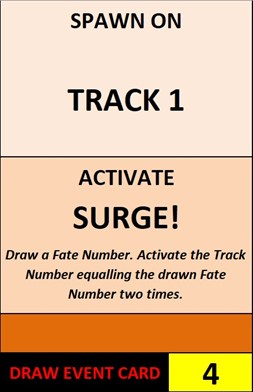
This is an example of a Fate Card. In this case, if you were drawing it for the Horrors activations due to drawing a Fate Cube, you would spawn some Horrors on Track #1 and then do a special activation called a “Surge!”. Players draw the next Fate Card and read its Fate Number (the yellow number on the bottom right). Assuming the next card is a “2”, players would activate the Horrors on track #2 twice! If you were drawing the above card after a Follow action, you would read the bottom left entry to see if you would need to draw an Event Card (and halting the Follow step). In this illustrated card, you would have to draw a card and resolve it immediately. And if this card were drawn for its Fate Number, the result would be a “4”. As you can see, each of these cards are multi-use and are used in many different situations and as a result to other occurrences that may happen during the turn.
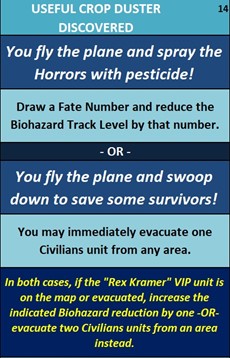
This is an example of a Search Card. If a unit opts to Search an eligible location (one that contains a special “Search” icon), the owning player draws the top card from the deck and simply reads the card aloud to the group. In this case, the unit has discovered a crop duster that has been abandoned here and might end up being useful…in some way! The player has the option of either flying the plane to spray the area with the chemical and reducing the biohazard level by the amount of a drawn Fate Number or flying the plane to save a Civilians unit and evacuate them. The bottom note tells you that if the players happen to have previously found the “Rex Kramer” VIP Civilians unit at some point during the game (and he isn’t eliminated), he will actually fly the plane for you and increase its bonus!
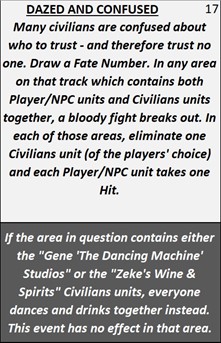
This is an example of an Event Card. If drawn, this card tells the players that something is not right with the civilians! They will attack the player’s units on a random track (determined again by drawing a Fate Number). However, if an area contains either of the two indicated Civilians units (either “Gene ‘The Dancing Machine’ Studios” or “Zeke’s Wine & Spirits”), then those particular civilians save the day in those areas and calm the situation down. These Event Cards test the players hard and if they have the resources, or have found various other surprises such as the mentioned Civilians, they can come out on top of the unexpected event.
Grant: What is the Follow mechanic? How does it work in the design and why is it important?
Hermann: The Follow mechanic is one that I first encountered playing Tiny Epic Galaxies. I immediately thought this was a brilliant design idea. It allows the other players to conduct basically a mini-turn of their own after a player’s regular turn. What that does is create a new level of strategy in the game, especially when considering cooperative play, and at the same time it keeps all players constantly engaged in the game. There is no down time since everyone is involved at all times during gameplay and might have an opportunity to do something out of turn. My little added twist to the mechanic is that in The Plum Island Horror, I’ve created a push-your-luck aspect to the Follow mechanic. After a player finishes their turn, the player to the left may opt to follow. If they do, they may conduct one eligible action. However, if they do so, they must then draw a Fate Card to determine if they have set off an Event (that’s the bottom left entry on the Fate Cards). If it says “No Event”, then everyone is safe and the next player can opt to do the same. However, if it says “Draw Event Card”, then the player must draw the top Event Card and enact it immediately. In addition to that, no further Follow actions can be taken by the remaining players that turn! So, the tension mounts as the Follows go around the table and some players may demand that the other players pass on the option and not take a Follow action in order to avoid the chance of a bad event. The group’s cooperation level is really tested in those cases.
Grant: What does the board look like?
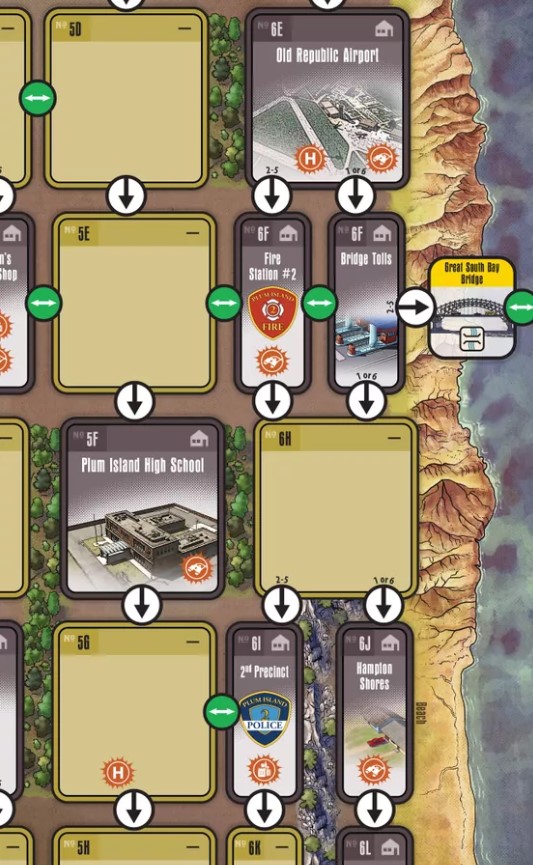
Hermann: The board is laid out with a map of Plum Island, which is rather long and thin. Superimposed on the map are six major tracks that run from the laboratory areas in the north down to the south end of the island, where Greenport and other areas are located. The tracks have a number of connected square areas which each can be empty or contain buildings, forests, beaches, mountains and rivers along the way – all identified with unique names.
Areas can also contain symbology which tells players if they can use their Search, Forage or Decontaminate actions in those places. Units will be moving from area to area along connections and in this game, units can also move laterally (including the Horrors) at certain points. There is even a suspension bridge to the mainland, which can cause all sorts of problems for the players – but can also provide some evacuation opportunities.
Grant: What different types of Horrors are there? How do they differ?
Hermann: There are two basic types of Horrors – Murders and Mutations. Murders are your “normal” Horrors and they travel in packs. They are deployed on the map in groups of counters and they will move together and even amalgamate with other groups. Their speed and strength is based on their size – the larger they are, the slower they move but the more deadly they are as well. Mutations are each unique and represent particularly bizarre and mutated creatures that each have a special strength or ability. They are represented in the game on standees and are quite dangerous to the players.
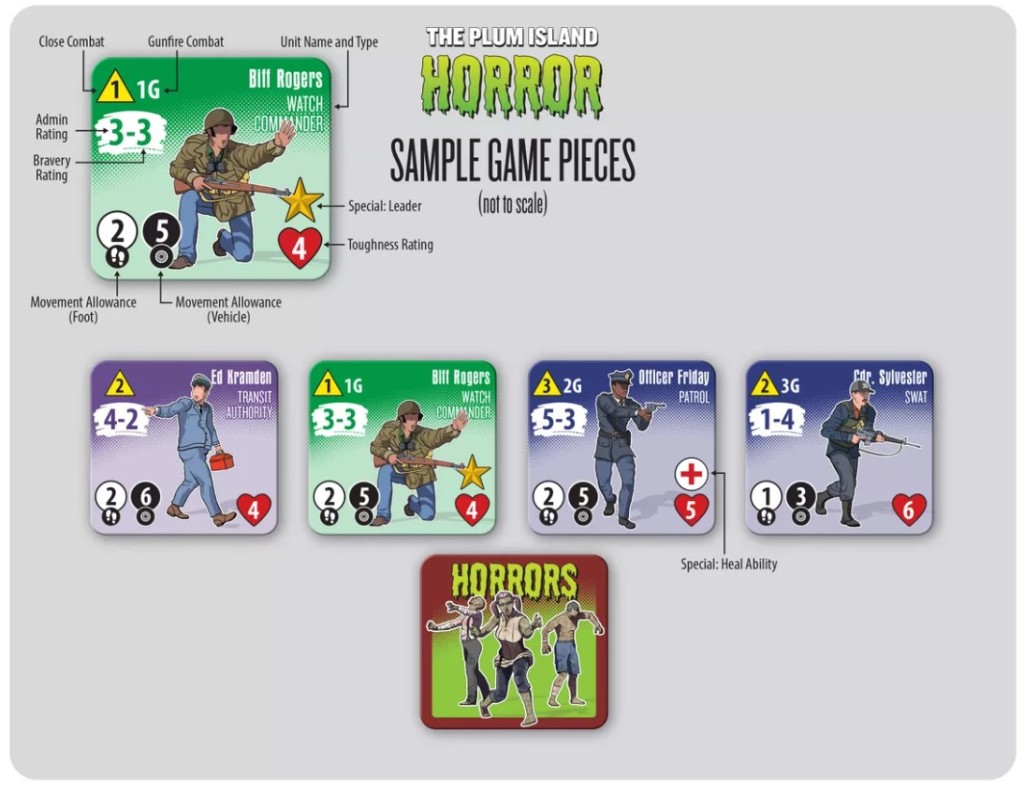
Grant: What Horrors are the most challenging to fight?
Hermann: A large Murder of Horrors is extremely dangerous if you let it catch your unit. If they get big enough, it’s almost impossible to stop them. But the aforementioned Mutations are the true dangers. They are made up of the Birds of Prey, Infected Sasquatch, Leper Messiahs (named after the Metallica song), Murder Hornets, Most Wanted Horrors and the Wild-Eyed Rats. All formidable monstrosities but if I had to pick one that is the most challenging, it’s probably the Leper Messiahs. They have great combat numbers and are pretty tough but what makes them nasty is that a unit may not attack them in Close Combat unless they have a Bravery Rating of “4” or better. If the Leper Messiah unit attacks a unit with a Bravery Rating of “3” or less, the Mutation’s Combat Rating goes up 50%!
Grant: How does combat work?
Hermann: The combat system is pretty fast and simple, as was my intention with this kind of game. It did go through a number of variations and in the end, I settled on a type of combat system seen in many dungeon crawls and adventure games. Horrors will only attack in Close Combat (hand-to-claw combat, if you will). Each Horrors unit will automatically inflict a certain number of Hits depending on its type. Murders inflict Hits based on the number of counters in the unit and the type of terrain in which the combat occurs. Each individual Mutation unit inflicts Hits per their particular Combat Rating, regardless of terrain. Player units always roll Combat dice and will inflict Hits based on the results of those dice and will also prevent Hits inflicted by the Horrors based on the number of “Shields” they roll. So, the dice serve two purposes – both attack and defense are resolved in one throw of the dice and this really speeds up the game. One important factor to note regarding combat – some player units have the ability to use Ranged Combat (i.e., gunfire, archery, explosives, etc.). This is essential as Close Combat always increases the Biohazard Level in the game – up close and personal combat is very “dirty”. With each Close Combat, players will be placing colored Biohazard Cubes into the Biohazard bag. And every turn, a number of these cubes will be drawn from the bag and their effects on the Biohazard Level recorded (I got the idea for this mechanic from the game Clank). Ranged Combat does not generate this biohazard danger – it is cleaner than Close Combat and is thus the preferred method of combat for the players. However, Ranged Combat requires supplies – and having enough supplies is another challenge entirely.
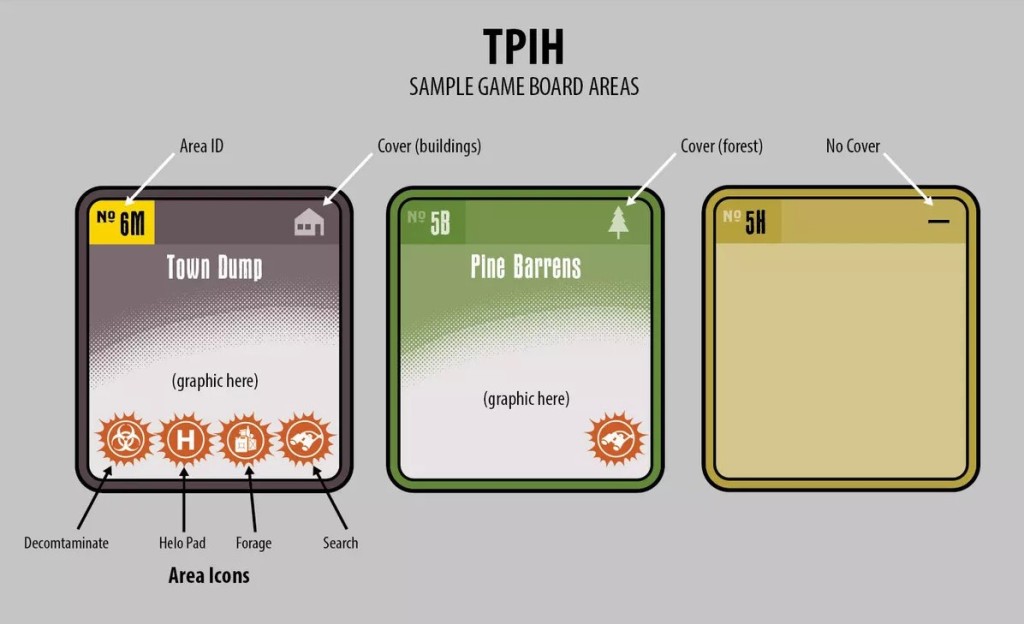
Grant: What is the makeup of the custom dice?
Hermann: The custom combat dice are six-sided and have five possible results on them.
Miss (two sides) = no effect
Light Hit = this counts as ½ Hit. So, a Hit is only scored if two of these are rolled. Some units have a special ability that counts these as a normal 1 Hit.
Hit = scores 1 Hit on the target.
Critical Hit = scores 1 Hit on the target and the player re-rolls this die to achieve an extra result. This is also known as an “exploding die” and I got this idea from Descent and some other dungeon crawler games. There is no limit to how many times this die can be rolled if a Critical Hit is rolled each time.
Shielded = In Close Combat, this result prevents 1 Hit being inflicted by a Horrors unit. In Ranged Combat, this counts as a “Hit” result unless the targeted Horrors unit is in a Building or Forest area – in those cases, this counts as a Miss.
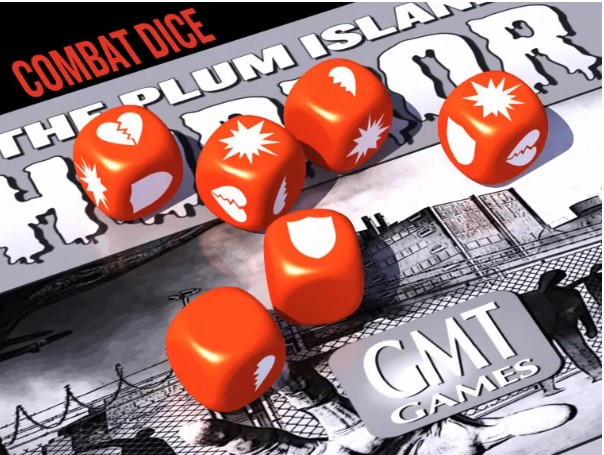
Grant: How is victory achieved?
Hermann: What’s this victory you speak of? It’s impossible to win this game, so that’s just crazy talk. 😊
Actually, the players win by not losing! There are four ways the Horrors can win the game and thereby the players lose the game. If players can work together and avoid these four conditions, it’s time to celebrate.
The Island Becomes a Toxic Wasteland! If the Biohazard Level hits “17” or more, the players lose. This measurement comes from the Biohazard cubes, which are drawn from the Biohazard bag each turn. Green cubes are safe, Yellow cubes are worth 1 level increase and red cubes are worth 2 level increases. There are also events that could occur during the game that increase the level and players may use the Decontaminate action if eligible and additionally some units are able to lower the level as a special ability.
The Island is Overrun by Monsters! There are seven “Overrun” areas located on the map and each is worth a certain number of Overrun Points. If the Horrors occupy such an area, they score those Overrun Points and if they manage to get “7” or more points, the players lose.
Oh! The Humanity! Evacuating civilians is a critical goal in the game. Not only are they each worth Evacuation Points, but if the Horrors kill one of them the Horrors actually grow in size! The players must collectively score at least “26” Evacuation Points, which they can do by evacuating Civilians units to the safety of Camp Captree on the mainland. They can be evacuated by boat, helicopter, walking across the suspension bridge, hiding them out in a Compound or by some events. If the players cannot score the necessary Evacuation Points, they will lose the game.
Where Is Everybody? If any faction has all six of its units eliminated, the players lose. The other factions become so disheartened and terrified that all hope is lost, and they flee to safety or try to hide out.
Grant: What are you most pleased with about the design?
Hermann: Well, first off I am so happy with the teamwork, cooperation and contributions from the GMT development crew. Ken Kuhn and Jason Carr have been outstanding in coordinating the playtesting and making valuable suggestions while providing me with some guidance as how to proceed. This is a massive project involving a lot of people and company assets. I really appreciate everyone taking the time to develop this game and I am thankful to all the playtesters for their terrific feedback. Secondly, this design is living proof of my overall design philosophy that games should be fun to design and fun to play. And this game has that in spades.
Also, it is also the embodiment of my efforts to play all sorts of different games and learn from each of them. You see references to these other games in my answers. There are so many cool games out there and each offers something unique – providing you with tools and sparking new, creative ideas. The Plum Island Horror is a smorgasbord of all that combined game design philosophy, wrapped into one box. It has a lot going on but yet, I think it’s a fairly simple game to play. It’s also highly variable, so should be a different experience each time you play it. Lastly, I love the spirit of cooperative game play. I think this design really promotes interaction amongst the players, allowing them to strategize together, be participants in an ever-changing collective story and, ultimately, to have a great time as a group and all laugh together.
Grant: What has been the experience of your playtesters?
Hermann: Oh, they have all been terrific and the entire group provided volumes of tangible, valuable feedback and suggestions. This is the kind of game that requires multiple plays with different combination of factions and playstyles. And the playtesters really gave it a thorough workout. For the most part, the playtesters embraced the idea of the game and got into the narrative. Like with Dawn of the Zeds, when I get feedback that essentially tells me the story of something entertaining that happened in the game, and it reads like a short story rather than a game-mechanic treatise, that’s the ultimate compliment for me. That means they enjoyed the game because what was happening on the game board was fun and immersive. Yes, I need game-mechanic details as well, but many lead with the narrative and that really made it a pleasant and rewarding experience.
Grant: What other games are you currently working on?
Hermann: How much space do you have on this page? 😊 I am working on about a dozen titles right now. I just came out with Volters Lead the Way! (White Dog Games) and The Hill of Death (Tiny Battle Publishing).
In the hopper are ….
- The second edition of A Most Fearful Sacrifice and the second game in the Black Swan Series on Chickamauga (Flying Pig Games).
- The third game in the Shattered Union series (after Claude Whalen’s second game in the series, Conquering the Valley, is published), which will be called Clear the Way and will be covering the Battle of Fredericksburg. Fred Manzo and I are also working on the fourth installment of the Invaders series called Planet of Doom!. I’m also half done with a baseball game called The Old Ballgame, which will be a unique, fast-playing take on the sport. (Tiny Battle Publishing)
- By Iron and Blood: Koniggratz 1866 is just about done and is a brand new game design depicting mid-19th century European warfare. If successful, we will follow it up with a game on Solferino, Custoza and some others. (White Dog Games)
- Death By Flags and Trumpets will be Kickstarted in the winter of this year or early next year. This is another brand new design covering the first five months of World War I on the western front. I have also started working on a game called Rain of Steel: The Franco-Prussian War and it’s a design using the Napoleon Returns 1815 system (which I love) that will cover both years of the Franco-Prussian War. (Worthington Games)
- Miracle at Dunkerque is done and we are just getting the artwork and graphics figured out. That should be ready by early next year. (Legion Wargames)
- Hell’s Half Acre: Stones River 1862 will be my next installment in the Blind Sword Series. That should be done by mid-to-late 2023. (Revolution Games)
- Night of the Zeds: Next year I plan on tackling a new Dawn of the Zeds game that will hearken back to the game’s second edition as far as its scope, footprint, and mechanics. It will be set in the future … a more post-apocalyptic theme that will follow the next generation of characters from the original game. I plan on fixing some of the mechanics – particularly combat – from that 2nd edition game and get it back to a design that a group of players can play easily together in 2-3 hours. (Tabletop Tycoon)
- The Stricken Land is an idea I’ve offered to GMT and it will be a fully cooperative fantasy wargame. Picture a Game of Thrones-type world where multiple players (each representing a particular race or clan in this fantasy world) must band together to fight off and defeat a great evil. This will be a somewhat traditional wargame (hexes and counters) but one where players must play cooperatively. I’ve also mentioned to them the desire to do a three-pack of small Franco-Prussian War and Austro-Prussian War tactical battles, using a new system. (GMT)
- I have two “secret” projects with European publishers that I can’t elaborate on yet. One is fully designed already and playtested and is just waiting for the graphics to be figured out. I can tell you it is a big science-fiction project and I’m really looking forward to it being published. The other project is in its infancy and won’t come to fruition until next year.
Thanks so much for letting me do this interview! I really enjoyed writing about The Plum Island Horror in detail. The game is in the art department right now and I can’t wait until the gamers out there see what it looks like – I think it will be gorgeous. Hopefully people will want to investigate it some more. All the best!

Thank you for your time in answering our questions Hermann and for all of your fantastic designs that we have played over the years, or look forward to playing. They are always well done and have brought us hours of enjoyment and that is what gaming is about. We have played many of your board games including Dawn of the Zeds, Attack of the 50′ Colossi, Escape from Hades and also have a new copy of Volters Lead the Way! that I look forward to playing soon as well as dozens of your wargames and always have a good experience. Thank you and I wish you luck in all of your upcoming projects!
If you are interested in The Plum Island Horror, you can pre-order a copy for $64.00 from the GMT Games website at the following link: https://www.gmtgames.com/p-940-the-plum-island-horror.aspx
-Grant
Awesome interview! Plenty of coming titles from Mr. Luttmann to keep us engaged. I P500’d this title — I think he captured the tone in this qoute, which I heard in Bill Murray’s voice from Caddyshack: “The faction does have its Security Guards unit, which zooms around on their Segways and is trained to fire on the move … so there’s that.”
LikeLiked by 1 person
Fantastic interview! This is a game I’ve had on my watch list. Dawn of the Zeds is by far THE best zombie game I’ve played; and that’s despite the theme being overdone. It captured the fight for survival, hero & disaster moments of a good Zombie flick. Tough game but brilliant.
Looking forward to this.
LikeLiked by 1 person